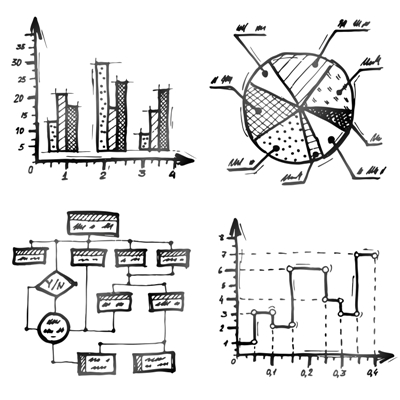They say a picture is worth a thousand words… “Telling the story” is one of the...
 The purpose of Financial Planning and Analysis (FP&A) is not to build perfect forecasts and financial solutions. The purpose is simply to make better business decisions. Numbers themselves can support decision-making, but the story convinces people to make the right decision. Because many leaders are often not financial thinkers, it's critical for FP&A professionals to know how their analysis and recommendations can be presented in a way that non-financial professionals can understand. This article will discuss best practices in data visualisation that resonate with financial and non-financial people alike.
The purpose of Financial Planning and Analysis (FP&A) is not to build perfect forecasts and financial solutions. The purpose is simply to make better business decisions. Numbers themselves can support decision-making, but the story convinces people to make the right decision. Because many leaders are often not financial thinkers, it's critical for FP&A professionals to know how their analysis and recommendations can be presented in a way that non-financial professionals can understand. This article will discuss best practices in data visualisation that resonate with financial and non-financial people alike.
Why is Data Visualisation Important for Businesses?
Business Intelligence software is easy to use, affordable, and offers an alternative to running filtered pivot tables and pivot charts in Excel. The incorporation of data visualisation platforms, such as Tableau, Qlik, and Power BI, is revolutionising how financial information is presented. It is our responsibility as FP&A professionals to inform the people who rely on our information to the extent it serves their needs as well as possible. We shouldn’t provide the audience with only a partial understanding, nor should we overcomplicate and overwhelm them. We need to present what’s most important.
While effective communication is often in job descriptions, requirements for formal training in data visualisation are generally not in most job descriptions. It’s also rare to come across a university curriculum that addresses how to build graphs, charts, and other visuals for data presentation appropriately. Since this isn’t an area where most people have received much, if any, training or coaching, how most people create presentations, graphs, and charts is based on their self-teaching. Sometimes they’re good, and sometimes they’re bad. Often, people don’t know that their methods for data visualisation are bad because they’ve seen so few examples of what well-designed visuals should look like. So often, FP&A presentations take place in PowerPoint and Excel, not because they’re the best platforms but because they’re the defaults.
Many visuals, like tables and graphs, can be difficult and time-consuming to read. They are often filled with information we don’t need and may even contain visual fluff that can be downright misleading. Some platforms allow visuals to be enhanced with all sorts of bells and whistles, which detract from the main message more than add to it. Relying on misleading information can, of course, be damaging to organisations, causing them to make bad decisions, lose money, and miss opportunities. Even worse, relying on misleading information can lead to catastrophic consequences.
How to Design a Good Data Visualisation?
When designing a data visualisation, the first questions that should be asked are the most important:
- What is the purpose of the data visualisation?
- What are the business questions we seek to answer?
- Who is the data visualisation for, what is their style for interpreting information, and what risks do they face in using information to make their decisions?
When we have answers to these questions, we should then ask how to present the information best. Data visualisation platforms can help.
On the one side, technology offers all sorts of features that help us present information in a wide array. Similarly, many technological solutions are full of enhancements that make them slightly more attractive than other platforms. But on the flip side, many people never learn how to properly present information in a clear and easy-to-understand way that helps us make good business decisions. Also, technology has, in some ways, made us complacent; we rely on the platform to present information how IT wants, rather than the opposite – we tell the platform how the data should be optimally visualised.
One of the best ways to assess the quality of a data visualisation is by grading its effectiveness. Stephen Few, one of the world’s leading experts in data visualisation, suggests effective data visualisation has seven criteria that fall into two general categories1. One category is informative, and the other is emotive, producing an emotional response. Within the informative category, data visualisation should be useful, complete, perceptible, truthful, and intuitive. Within the emotive category, data visualisation should be aesthetic and engaging. When a data visualisation is graded highly on all seven criteria, it is reasonable to say objectives are being met.
When there’s so much visual information to review, audiences often don’t know what’s most important. Without a keen ability to present and influence, stand-alone data visualisations lack impact. FP&A professionals should seek to manage information flow before, during, and after presentations and improve their credibility through public speaking skills.
In the day or days leading up to a meeting or presentation, share a list of participants to be in attendance, an agenda with key discussion points, and timing for keeping the session on track. In this ‘pre-work’ communique, provide background, details, and analysis that will be discussed. This way, when attendees are in the presentation, most already have a good background of what will be discussed. It saves a tremendous amount of time and distraction.
At the outset of the meeting or presentation, clearly state the objective of the session and the goals of the individuals in attendance. Ideally, the meeting or presentation will be linear and to the point, with the main takeaways to be decided and the next steps to be taken. Sessions shouldn’t be informational discussions; they should be action-oriented. Data visualisation should enhance the conversation and not distract from it. At the end of the meeting or presentation, details, supporting analysis, and other important but not pertinent information should be provided as a supplement to not distract from the live conversation.
Conclusion
We’re entering an era in FP&A where we have an abundance of big data. This information can provide deep insights into our business and world; however, it must be used intelligently. We need not give in to the defaults our Business Intelligence and analytics platforms provide simply out of complacency. We can deliberately design beautiful, yet extremely practical, data visualisations to better stories and make quicker, smarter decisions.
- FEW, Stephen. “Data Visualisation Effectiveness Profile.” Perceptual Edge Visual Business Intelligence Newsletter. January/February/March 2017.
This article was first published in Unit4/Prevero Blog.
Subscribe to
FP&A Trends Digest

We will regularly update you on the latest trends and developments in FP&A. Take the opportunity to have articles written by finance thought leaders delivered directly to your inbox; watch compelling webinars; connect with like-minded professionals; and become a part of our global community.






